|
|
 |
 |
| |
|
|
|
| |
| |
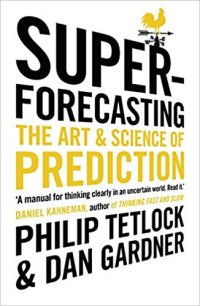 Superforecasting: The Art and
Science of Prediction Superforecasting: The Art and
Science of Prediction
by by Philip Tetlock (Author), Dan Gardner
(Author)
"The techniques and habits
of mind set out in this book are a gift to anyone who has to think about what
the future might bring. In other words, to everyone." (Economist)
"Full
of excellent advice – it is the best thing I have read on predictions . .
. Superforecasting is an indispensable guide to this indispensable activity."
(The Times)
The best way to know if an idea is right is to see if it
predicts the future. But which ideas, which methods, which people have a track
record of non-obvious predictions vindicated by the course of events? The
answers will surprise you, and they have radical implications for politics,
policy, journalism, education, and even epistemology – how we can best
gain knowledge about the world.
"Experts are about as accurate as chimps
when predicting the future". This tidbit, so often mentioned when discussing
(or dismissing) expert opinion or predictions, originates from the research of
Mr. Tetlock on Expert Political Judgement. A natural next step was figuring out
if anyone could reliably answer questions about the not so distant future and
the result was the Good Judgment Project. The main results are detailed in this
book, there indeed exists a group of super-forecasters who manage to constantly
out-predict the chimps and experts in the intelligence community.
The
book describes some of the characteristics of a super-forecaster. Not
surprisingly they are, in general, good with numbers and ingest a lot of
information. They tend to be slow thinkers, in the sense of Kahneman, and at
least in some cases not as much affected by cognitive biases.
Super-forecasters, however, are not super-human. Forecasting is a skill that
can be learnt or improved.
Paperback - 352 pages - Random House Books; 01
edition (7 April 2016) £7.13
Kindle - 354 pages
Cornerstone Digital; 01 edition (24 Sept. 2015) £2.46
 Audiobook - 9 hours
45 minutes £16.44 Audiobook - 9 hours
45 minutes £16.44
|
| |
|
| |
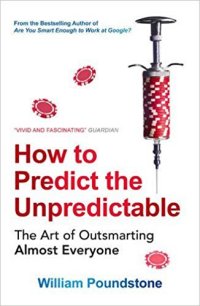 How to Predict the Unpredictable: The Art of
Outsmarting Almost Everyone How to Predict the Unpredictable: The Art of
Outsmarting Almost Everyone
by William Poundstone
Poundstone puts your money where his mouth
is, with a set of betting systems. He describes the kinds of football games on
which you might be able to beat bookmakers' odds, and advises on how to play
the office Oscars pool. The mother of all betting systems, of course, is a
stock-market investment strategy, and Poundstone offers one of those, too: a
long-term plan based on price-to-earnings ratios and sitting out periods of
volatility.
The most fascinating part of the book is a series of
chapters in which Poundstone shows how sets of fraudulent numbers in made-up
accounts or massaged expenses fall prey to the same kind of analysis. People
overuse descending pairs (21, 43, 76), and over-avoid doubled digits (55, 88);
they don't know that there are surprisingly uneven distributions of first and
second digits in sets of numbers from disciplines including finance and sport
statistics. For such reasons, there were good reasons to be suspicious of
Enron's revenue figures and Bernie Madoff's investment returns long before
those scandals broke.
Paperback - 304 pages - Profile Books (1st Jun
2015) £4.53
Kindle - 304 pages Oneworld
Publications (9 April 2014) £4.99
 |
|
|
| |
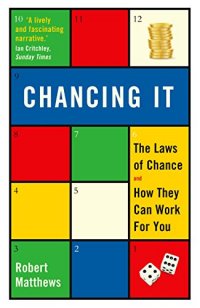 Chancing it: The Laws of chance and How They Can
Work for You Chancing it: The Laws of chance and How They Can
Work for You
by Robert Matthews
The book Chancing It from Robert Matthews, one of the world's
greatest science writers, is the Rothschild among all those many books on
popular probability that appeared in the past years. Yes, the book contains
highly interesting stories about coincidences, lotteries and casino games, and
it gives many real-life cases that demonstrate the different facets of the laws
of probability.
But, more importantly, the book explains clearly
how to spot false scientific claims based on the use of dodgy statistics, and
pays attention to statistical controversies that have rarely been discussed
outside academia. I never saw explained in such an accessible way the misuse
and overreliance on p-values in medical publications, the dangers of mindlessly
applying the normal distribution to financial data, misunderstandings about
correlations, etc. The book is a must for everyone who is interested in
probability and statistics or who is professionally involved in these subjects.
Highly recommended!
Paperback - 304 pages - Profile Books (19 Jan.
2017) £9.99
 Kindle 304 pages - Profile Books (19 Jan.
2017) £4.79 Kindle 304 pages - Profile Books (19 Jan.
2017) £4.79
|
| |
|
 Probability Guide to Gambling: The Mathematics of
Dice, Slots, Roulette, Baccarat, Blackjack, Poker, Lottery and Sport
Bets Probability Guide to Gambling: The Mathematics of
Dice, Slots, Roulette, Baccarat, Blackjack, Poker, Lottery and Sport
Bets
by Catalin Barboianu
This is probably the most useful book from Barboianu's serial of
gambling maths. And is far superior than Packel's or even Thorpe's book, whose
approach is mostly statistical. Gamblers may easily skip the maths sections and
go directly to the odds table they need, due to a professional organization of
the content.
The book contains much new and original material that has
not been published previously and provides great coverage of probabilities for
the following games of chance: Dice, Slots, Roulette, Baccarat, Blackjack, Five
Card Draw Poker, Texas Hold'em Poker, Lottery and Sport Bets.
It begins
by explaining in simple terms the meaning of the concept of probability for the
layman and goes on to become an enlightening journey through the mathematics of
chance, randomness and risk. It then continues with the basics of discrete
probability (definitions, properties, theorems and calculus formulas),
combinatorics and counting arguments for those interested in the supporting
mathematics.
These mathematic sections may be skipped by readers who do
not have a background in mathematics; these readers can skip directly to the
"Guide to Numerical Results" to pick the odds and recommendations they need for
the desired gaming situation.
 Paperback - 332 pages - Infarom (26 Aug
2006) £10.99
Paperback - 332 pages - Infarom (26 Aug
2006) £10.99
No Knidle
 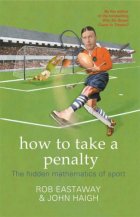 How to Take a Penalty: How to Take a Penalty:
The Mathematical
Curiosities of Sport
by Rob Eastaway, John Haigh
'An interesting read for even the most
maths-phobic'. The Good book guide
Why might it help a penalty
taker to look at a clock before he kicks the ball? Does winning the toss
actually matter? And why should some people consider playing darts blindfold?
'How to Take a Penalty' takes a novel and intriguing look at sport, by
exploring the mathematics behind the action. Discover, for instance, the
surprising links between boxing and figure skating and between American
football and cricket, the unusual location of England's earliest 'football' (in
a parish church), the 26.5-degree 'trick' snooker shot, the pros and cons of
being a consistent golfer, and the formula for winning a game of tennis.
With a subtitle 'the hidden mathematics of sport' I thought this might
be dry, but in fact I read it in one sitting. The maths in here is accessible,
and the harder stuff is stuck away in the appendix. Lots of sports included,
though the most commonly referred to are football, cricket, tennis, rugby and
athletics. Great chapter on darts. A very interesting read.
Hardcover - 192 pages (June 17, 2005)
£0.15
No Knidle
 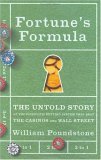 Fortune's Formula: The Untold Story of the
Scientific Betting System That Beat the Casinos and Wall Street Fortune's Formula: The Untold Story of the
Scientific Betting System That Beat the Casinos and Wall Street
by
William Poundstone
This is an
excellent book about the discovery of the Kelly formula that is unknown outside
gambling. This story has three protagonists. Two of them were scientists
working at Bell Labs: Claude Shannon, a genius polymath who developed
information theory; and John Kelly, a maverick genius, who is directly
responsible for the development of Kelly's formula. The third one is a
brilliant MIT mathematician, Ed Thorp.
As the author states, Ed Thorp's
genius consists in "...his continuous ability to discover new market
inefficiencies ... as old ones played out." Ed Thorp closed this second fund in
2002. He is now independently exploring inefficiencies in gambling.
Claude Shannon amassed large wealth by recording one of the best
investment records. His performance had little to do with Kelly's formula.
Between 1966 and 1986, his record beat even Warren Buffet (28% to 27%
respectively). Shannon strategy was similar to Buffet. Both their stock
portfolios were concentrated, and held for the long term. Shannon achieved his
record by holding mainly three stocks (Teledyne, Motorola, and HP). The
difference between the two was that Shannon invested in technology because he
understood it well, while Buffet did not.
John Kelly was a chain
smoking, gun collecting brilliant physicist. He died young at 41 of an
aneurysm. He worked closely with Shannon at Bell Labs. Besides being a
charismatic character the author does not write much about his life compared to
the other two.
Paperback -
386 pages Non Basic Stock Line (19 Sept. 2006) £13.96
No Knidle
  Against the Gods: The Remarkable Story of
Risk Against the Gods: The Remarkable Story of
Risk
by Peter L. Bernstein
Bernstein has managed to take a subject which at first sight
seems intensely boring, and has made it fascinating. Whether or not you have
any interest in Risk, Statistics or Econimics, you owe it to yourself to read
this book. It is quite simply a "Ripping Yarn". Its greatness lies in
Bernstein's ability to tell the story in an accessible manner, without dumbing
down the essential facts. Let me say it again: Read this book because it is a
fascinating and well written story. The fact you will know a lot more about
Risk at the end of it is an incidental, but very welcome, extra.
Paperback - 400 pages John
Wiley & Sons; New Ed edition (29 Sept. 1998) £11.33
Kindle - 383 pages Wiley; 1
edition (21 April 2008) £10.76
|
|
| |
| |
|
|
|
| |
| |
|
 |
|